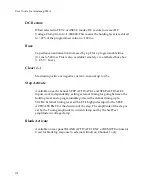
Troubleshooting
Symptom:
The
time
‐
course
of
the
voltage
step
is
slower
than
the
current
transient.
The
peaks
of
the
current
transients
are
clipped
(have
a
flat
top).
Possible
cause:
The
current
‐
passing
side
of
the
voltage
clamp
is
saturating.
If
this
is
the
case
then
variation
in
the
gain
around
its
maximum
level
will
have
little
effect
on
the
voltage
rise
time.
Most
likely
the
output
amplifier
is
saturating,
but
if
you
are
using
a
virtual
ground
headstage
to
measure
current
then
the
saturation
may
be
occurring
there.
Suggestions:
If
the
rise
time
is
adequate
and
non
‐
linear
capacitive
currents
are
acceptable,
then
there
is
no
problem.
If
the
saturation
is
not
acceptable,
then
reducing
the
resistance
of
the
current
‐
passing
microelectrode
may
help
considerably.
If
you
halve
this
resistance
you
halve
the
output
voltage
required
to
drive
the
same
current.
If
the
problem
lies
in
the
virtual
‐
ground
unit,
use
another
one
with
higher
range.
All
Voltage
‐
Clamp
Modes
Symptom:
Unable
to
offset
the
voltage
microelectrode
voltage
to
zero.
Possible
causes:
There
may
be
a
break
in
the
connection
between
the
headstage
input
and
ground,
causing
the
input
to
float.
The
capacitance
neutralization
circuit
may
be
oscillating.
Suggestions:
Check
the
electrical
continuity
and
DC
stability
of
the
voltage
recording
and
bath
ground
electrode
holders.
Check
for
bubbles
in
the
microelectrodes.
Observe
the
voltage
signal
at
a
wide
bandwidth
to
check
that
the
capacitance
neutralization
circuit
is
not
in
oscillation.
Symptom:
Persistent
overshoot
during
a
voltage
step.
High
voltage
and
current
noise.
Cannot
be
“tuned”
out.
Possible
cause:
If
you
are
using
an
external
voltage
command,
examine
the
command
signal
on
an
oscilloscope.
The
command
signal
itself
may
overshoot
during
a
voltage
step.
Some
D/A
converters
can
also
have
high
levels
of
digital
switching
noise.
163
















































